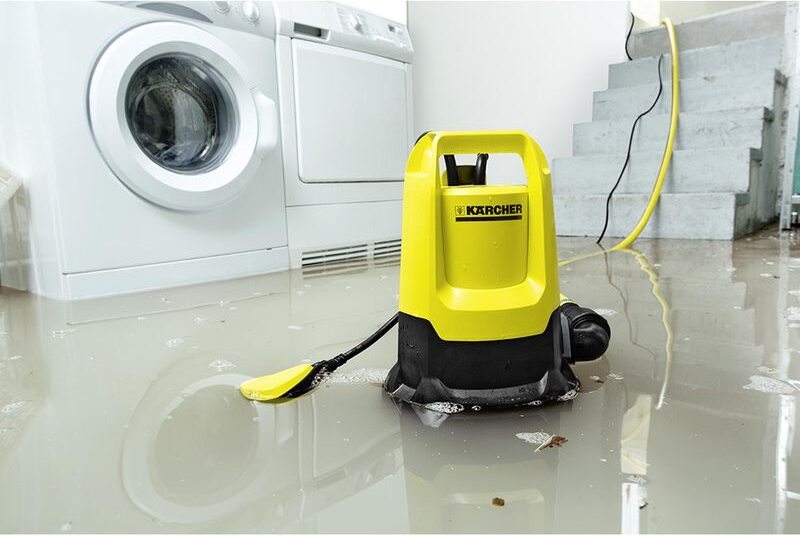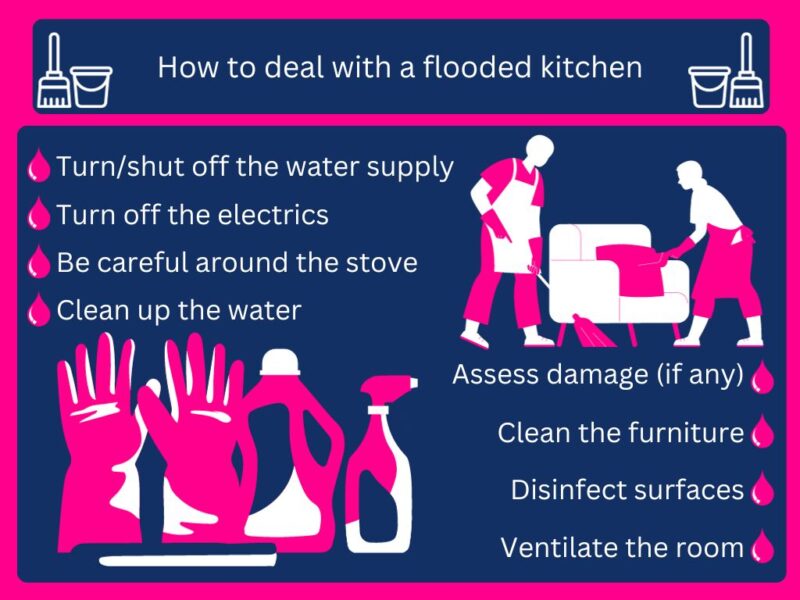There are some appliances we can’t live without. Those appliances, however, like sinks or washing machines, can sometimes malfunction. As much as we don’t want them to, floods happen. When they do, you must deal with the issue right away.
Whether it’s a clogged pipe, a broken cleaning appliance or external weather factors that have caused the kitchen to flood, there are ways to deal with the mess presented to you. We’ll explore these via our guide to help you act before the issue worsens.
Table of contents
Flooded kitchen floor – What to do
Restoring your kitchen to its former glory after a flood can be done in simple steps.
So, what can you do?
Step one: Turn/shut off the water supply
The water supply will definitely need to be turned/shut off to prevent further flooding. Traditionally, this is done by shutting off the stopcock, which can be found below the kitchen sink.
Step two: Turn off the electrics
Once the water has stopped flowing, turn off the electricity via the circuit to the room on the consumer unit. This is traditionally found under the stairs or near your front door. This will help limit the volts entering the kitchen.
If other areas in the home have been affected by the flooding, isolating the power to those rooms is advised.
With that said, if the water is around any live electrics, do not touch this. Contact a suitable electrical service for repairs.
Step three: Take care with the stove
If you have a gas stove, you may need to replace some components such as:
- Supply lines
- Bottom burners
- Regulators
The water on the kitchen floor can affect these. Regarding the supply line, if you have concerns that the stove is compromised, exit the property right away. Once you’re out of harm’s way, you must contact the National Grid gas emergency line on 0800 111 999 to request support.
Step four: Time to clean up the water
Remove any furniture out of the way before you start to clean (tables, chairs etc.), as this will ease the process and ensure the room can vent more effectively.
If there are floor-standing cabinets or low wall-hung cabinets, check these for water. Clean any you find that have become affected by water.
A mop and a bucket are the primary ways to deal with kitchen flooding if there is minimal water, but a water pump or vacuum suitable for wet cleaning can speed up the cleaning process (especially if there is a large volume of water).
Warning: Don’t use newspaper on the surfaces to soak up the water. The ink may bleed onto the kitchen floor, counters, etc. Any electrics affected by the flood must be thoroughly inspected by a professional before use to confirm whether they are safe after the flooding.

Step five: Look for damage
Following the water cleanup, assess for damage, particularly to drywalls and door frames. These can be permeable compared to features.
Floods that occurred while you were away for longer than a day could be more problematic. At this time, stagnant water would likely cause dampness and encourage mould to grow. In this case, contact an expert flood and water damage company to deal with the excessive dirt and grime.
Speaking of dampness, we have a guide dedicated to reducing condensation in a loft. Go ahead and check it out for more tips for drying out a damp attic space.
Step six: Ventilate the room
Ventilation needs to be as thorough as possible in the room. Opening windows is one of the best ways to do this, but you can also use fans. Dehumidifiers can also quicken the room’s drying.
Any cabinets with doors and any drawers in the kitchen must be kept open. Again, pay attention to drywalls to ensure no damp or mould is forming.

Step seven: Cleaning up furniture
Dry off any wet furniture, wiping any upholstery down meticulously. If you own wooden furniture, take care because the water could have debilitated the wood.
As a last, must-do act, you should disinfect any surfaces affected by the flooding as much as possible. Not only for appearance’s sake but also to ensure the surface is safe for cooking, eating and storing food.
There you have it. The ways you can start cleaning up your kitchen from a flood. Now, if you find drying out the flooded kitchen has been a failure, contact professionals to help restore the property.
So, to summarise:

If you have other flooding concerns, our Flood Hub has a lot of information to help you out. From an essential guide to flood recovery to preventing clay gardens from flooding and more, we’re confident we can help you with your flood concerns.









